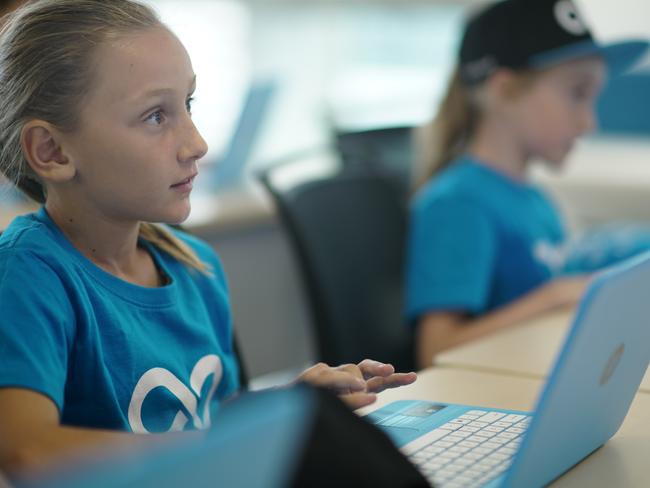Code Camp aims to teach 200,000 Aussie kids to code by 2020
IT’S not Mandarin or French. There’s one language that will soon be the most understood in the world and Australia is woefully lagging behind.
FOR Australian kids in schools right now the most important language they will learn might not be French, German or Mandarin but rather computer coding.
It might sound strange to equate the two but the languages of coding and computer programming will soon be the most commonly understood in the world.
Back in 2013, Sydneysiders Ben Levi and Peter Neill were working in a shared office space dedicated to tech start-ups when they began helping a handful of people around them to write code. Pretty soon they had more takers.
What started as a hobby has since grown into a nationwide education initiative called Code Camp, which has now taught more than 18,000 primary school students across the country to write code in holiday programs, after school camps and classrooms in both private and public schools.
Today the company has 23 fulltime staff and about 1000 casual staff who are deployed across the nation to teach the craft of coding.
By 2020 they hope to have taught 200,000 Aussie students the “super power” and have recently struck up a deal with electronics giant HP to provide PCs and support, to help reach the ambitious goal.
We want to “create future entrepreneurs, innovators and change-makers,” said Mr Levi. “The jobs of tomorrow are about problem solving and being creative.”
He believes an understanding of the language that underpins our digital world will be vital for many jobseekers of the future, in part because when it comes to coding, “schools aren’t doing it.”
The tech industry argues there is a severe shortage of Australians skilled up for jobs in the sector and more needs to be done in training.
For more than two years now, “coding in every Australian school” has been an official policy of the Australian Labor Party.
Last year the Queensland state government announced it would make coding a compulsory part of the curriculum beginning this year.
Mr Levi believes there is no doubt that the other states will follow suit in the coming years but the longer we wait, the more some kids will miss out.
Belgium, the Netherlands, Finland, Estonia and England have all mandated coding and programming classes in school with kids as young as five learning to code and create their own computer games.
Meanwhile US-led initiatives such as Code.org and the Hour of Code, backed by organisations like Microsoft and Google champion the need for young students around the world to have the opportunity to learn coding.
“I think we’re in a good place now to learn from other countries and see what’s worked and what hasn’t,” Mr Levi said. “So while we may be starting a bit behind, we can make sure we have the biggest impact possible for the future.”

Code Camp offers four different levels of programs for kids ranging from kindergarten to year six. They begin with drag and drop functions to teach the logic of basic functions before moving onto popular programming languages such as Java.
Among the Code Camp alumni is an 8-year-old girl who after attending classes was able to build a website designed to help her dad to quit smoking.
A 13-year-old named Aiden now has “two or three” apps in the Apple app store after first learning to build them at Code Camp and then further teaching himself on YouTube, Mr Levi said.
Some of the kids show such promise that he even has his eye on them for future job positions.
“There is a 9-year-old we regularly joke with his mother that if she would let him drop out of school, we would hire him,” Mr Levi said. “He has the skills that some people have coming out of uni.”
According to the Immediate Past President of Australian Computer Society Brenda Aynsley, the language of programming “in ten years’ time, will be the most common language in the world. You need to teach a language as early as possible to allow for maximum fluency in a child.”
Exposing both students and their teachers to programming means demystifying an area that can be intimidating and unfamiliar for many. And simply commencing that process is a critical step in the push to teach 200,000 Aussie kids to code.



